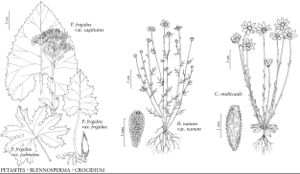Crocidium
Fl. Bor.-Amer. 1: 335, plate 118. 1834.
Annuals, (2–) 4–12 (–30) cm (usually glabrous but for axillary tomentum). Stems usually 1, erect, simple or branched near bases. Leaves (± fleshy) basal and cauline; alternate; petiolate (basal) or sessile; blades palmately nerved, spatulate or oblanceolate (basal) to lanceolate or linear, margins toothed or entire, faces glabrous or glabrate. Heads radiate, borne singly. Calyculi 0. Involucres ± hemispheric, 3–6+ mm diam. Phyllaries (veiny, often purple-tipped, each subtending a ray-floret) persistent, 5–13+ in 1 (–2) series, erect (reflexed in fruit), basally connate, elliptic to ovate, subequal, margins herbaceous to membranous. Receptacles dome-shaped to conic (heights equaling or greater than diameters), smooth, epaleate. Ray-florets 5–13+, pistillate and fertile or neuter; corollas yellow (laminae conspicuous). Disc-florets 12–60 (–120+), bisexual, fertile; corollas yellow, tubes ± cylindric, longer than or equaling campanulate to cylindric throats, lobes 5, erect to spreading, deltate to lanceolate; style-branches stigmatic in 2 lines, apices truncate-penicillate. Cypselae (stramineous to reddish-brown) ± ellipsoid to fusiform, 5 (–6) -nerved, ± papillate-hairy between nerves (papillae mucilaginous when wetted); pappi fragile or readily falling, usually of 20–40, white, barbellulate bristles (in 1 series), sometimes 0 on ray cypselae. x = 9.
Distribution
w North America
Discussion
Species 1.
Selected References
None.
